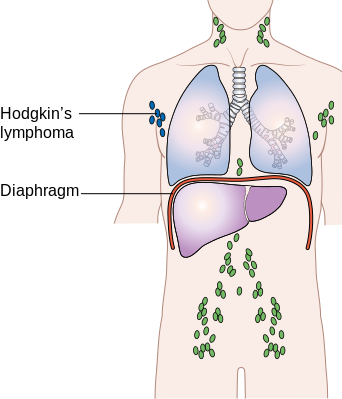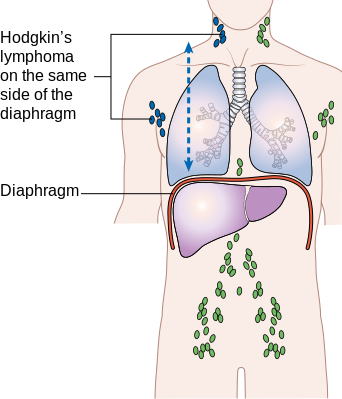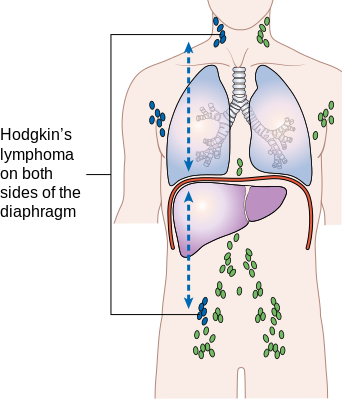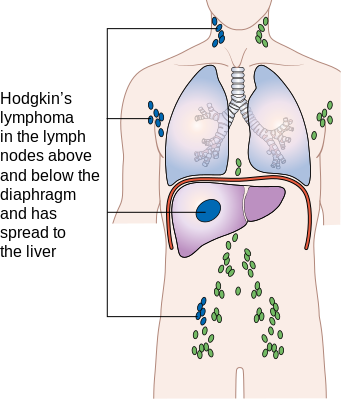Hodgkin's lymphoma staging: Difference between revisions
No edit summary |
m (Bot: Removing from Primary care) |
||
| (10 intermediate revisions by 3 users not shown) | |||
| Line 4: | Line 4: | ||
{{CMG}}; {{AE}} {{AS}} | {{CMG}}; {{AE}} {{AS}} | ||
==Overview== | ==Overview== | ||
According to the Lugano classification | According to the Lugano classification and Cotswold's modification of the original Ann arbor staging system, there are four stages of Hodgkin's lymphoma based on the number of nodes and extranodal involvement. | ||
==Staging== | ==Staging== | ||
According to the Lugano classification | According to the Lugano classification<ref>{{Cite journal| doi = 10.1200/JCO.2013.54.8800| issn = 1527-7755| volume = 32| issue = 27| pages = 3059–3068| last1 = Cheson| first1 = Bruce D.| last2 = Fisher| first2 = Richard I.| last3 = Barrington| first3 = Sally F.| last4 = Cavalli| first4 = Franco| last5 = Schwartz| first5 = Lawrence H.| last6 = Zucca| first6 = Emanuele| last7 = Lister| first7 = T. Andrew| last8 = Alliance, Australasian Leukaemia and Lymphoma Group| last9 = Eastern Cooperative Oncology Group| last10 = European Mantle Cell Lymphoma Consortium| last11 = Italian Lymphoma Foundation| last12 = European Organisation for Research| last13 = Treatment of Cancer/Dutch Hemato-Oncology Group| last14 = Grupo Español de Médula Ósea| last15 = German High-Grade Lymphoma Study Group| last16 = German Hodgkin's Study Group| last17 = Japanese Lymphorra Study Group| last18 = Lymphoma Study Association| last19 = NCIC Clinical Trials Group| last20 = Nordic Lymphoma Study Group| last21 = Southwest Oncology Group| last22 = United Kingdom National Cancer Research Institute| title = Recommendations for initial evaluation, staging, and response assessment of Hodgkin and non-Hodgkin lymphoma: the Lugano classification| journal = Journal of Clinical Oncology: Official Journal of the American Society of Clinical Oncology| date = 2014-09-20| pmid = 25113753}}</ref> and Cotswold's modification of the original Ann arbor staging system,<ref name=radio> Hodgkin lymphoma. Dr Amir Rezaee and Dr Frank Gaillard et al. Radiopaedia.org 2015.http://radiopaedia.org/articles/lymphoma-staging</ref><ref>Hodgkin-lymphoma. Canadian Cancer Society. http://www.cancer.ca/en/cancer-information/cancer-type/hodgkin-lymphoma/staging/?region=ab Accessed on September 11, 2015</ref> there are four stages of Hodgkin's lymphoma based on the number of nodes and extranodal involvement. | ||
Staging for Hodgkin's lymphoma is provided in the following tables: | Staging for Hodgkin's lymphoma is provided in the following tables: | ||
| Line 15: | Line 14: | ||
! style="background: #4479BA; color:#FFF;" | Stage | ! style="background: #4479BA; color:#FFF;" | Stage | ||
! style="background: #4479BA; color:#FFF;" | Involvement | ! style="background: #4479BA; color:#FFF;" | Involvement | ||
! style="background: #4479BA; color:#FFF;" | | ! style="background: #4479BA; color:#FFF;" | Extra nodal (E) status | ||
|- | |- | ||
| style="padding: 5px 5px; background: #DCDCDC;" colspan=3 | '''Limited''' | | style="padding: 5px 5px; background: #DCDCDC;" colspan=3 | '''Limited''' | ||
| Line 21: | Line 20: | ||
| style="padding: 5px 5px; background: #F5F5F5;" | I | | style="padding: 5px 5px; background: #F5F5F5;" | I | ||
| style="padding: 5px 5px; background: #F5F5F5;" | One node or a group of adjacent nodes | | style="padding: 5px 5px; background: #F5F5F5;" | One node or a group of adjacent nodes | ||
| style="padding: 5px 5px; background: #F5F5F5;" | Single | | style="padding: 5px 5px; background: #F5F5F5;" | Single extra nodal lesions without nodal involvement | ||
|- | |- | ||
| style="padding: 5px 5px; background: #F5F5F5;" | II | | style="padding: 5px 5px; background: #F5F5F5;" | II | ||
| style="padding: 5px 5px; background: #F5F5F5;" | Two or more nodal groups on the same side of the diaphragm | | style="padding: 5px 5px; background: #F5F5F5;" | Two or more nodal groups on the same side of the diaphragm | ||
| style="padding: 5px 5px; background: #F5F5F5;" | Stage I or II by nodal extent with limited contiguous | | style="padding: 5px 5px; background: #F5F5F5;" | Stage I or II by nodal extent with limited contiguous extra nodal involvement | ||
|- | |- | ||
| style="padding: 5px 5px; background: #F5F5F5;" | II bulky* | | style="padding: 5px 5px; background: #F5F5F5;" | II bulky* | ||
| Line 38: | Line 37: | ||
|- | |- | ||
| style="padding: 5px 5px; background: #F5F5F5;" | IV | | style="padding: 5px 5px; background: #F5F5F5;" | IV | ||
| style="padding: 5px 5px; background: #F5F5F5;" | Additional noncontiguous | | style="padding: 5px 5px; background: #F5F5F5;" | Additional noncontiguous extra lymphatic involvement | ||
| style="padding: 5px 5px; background: #F5F5F5;" | Not applicable | | style="padding: 5px 5px; background: #F5F5F5;" | Not applicable | ||
|} | |} | ||
{| style="border: 0px; font-size: 90%; margin: 3px;" align=center | {| style="border: 0px; font-size: 90%; margin: 3px;" align=center | ||
| Line 53: | Line 53: | ||
|- | |- | ||
| style="padding: 5px 5px; background: #F5F5F5;" | IE | | style="padding: 5px 5px; background: #F5F5F5;" | IE | ||
| style="padding: 5px 5px; background: #F5F5F5;" | One | | style="padding: 5px 5px; background: #F5F5F5;" | One extra nodal site | ||
|- | |- | ||
| style="padding: 5px 5px; background: #DCDCDC;" colspan=3 | '''stage II''' | | style="padding: 5px 5px; background: #DCDCDC;" colspan=3 | '''stage II''' | ||
| Line 61: | Line 61: | ||
|- | |- | ||
| style="padding: 5px 5px; background: #F5F5F5;" | II E | | style="padding: 5px 5px; background: #F5F5F5;" | II E | ||
| style="padding: 5px 5px; background: #F5F5F5;" | | | style="padding: 5px 5px; background: #F5F5F5;" | Localized extra nodal site with stage II criteria, both on the same side of the diaphragm | ||
|- | |- | ||
| style="padding: 5px 5px; background: #DCDCDC;" colspan=3 | '''stage III''' | | style="padding: 5px 5px; background: #DCDCDC;" colspan=3 | '''stage III''' | ||
| Line 73: | Line 73: | ||
|- | |- | ||
| style="padding: 5px 5px; background: #F5F5F5;" | III E (2) | | style="padding: 5px 5px; background: #F5F5F5;" | III E (2) | ||
| style="padding: 5px 5px; background: #F5F5F5;" | With | | style="padding: 5px 5px; background: #F5F5F5;" | With localized extra nodal site | ||
|- | |- | ||
| style="padding: 5px 5px; background: #F5F5F5;" | III SE | | style="padding: 5px 5px; background: #F5F5F5;" | III SE | ||
| Line 81: | Line 81: | ||
|- | |- | ||
| style="padding: 5px 5px; background: #F5F5F5;" | IV | | style="padding: 5px 5px; background: #F5F5F5;" | IV | ||
| style="padding: 5px 5px; background: #F5F5F5;" | Disseminated involvement of one or more | | style="padding: 5px 5px; background: #F5F5F5;" | Disseminated involvement of one or more extra lymphatic organ (e.g. lung, bone) +/- any nodal involvement | ||
|- | |- | ||
| style="padding: 5px 5px; background: #DCDCDC;" colspan=3 | '''Additional staging variables''' | | style="padding: 5px 5px; background: #DCDCDC;" colspan=3 | '''Additional staging variables''' | ||
| Line 96: | Line 95: | ||
|- | |- | ||
| style="padding: 5px 5px; background: #F5F5F5;" | E | | style="padding: 5px 5px; background: #F5F5F5;" | E | ||
| style="padding: 5px 5px; background: #F5F5F5;" | | | style="padding: 5px 5px; background: #F5F5F5;" | Extra nodal: other than the lymph nodes or spread to tissues beyond, but nearby, the lymphatic tissues | ||
|- | |- | ||
| style="padding: 5px 5px; background: #F5F5F5;" | S | | style="padding: 5px 5px; background: #F5F5F5;" | S | ||
| style="padding: 5px 5px; background: #F5F5F5;" | Spleen | | style="padding: 5px 5px; background: #F5F5F5;" | Spleen | ||
|- | |- | ||
| style="padding: 5px 5px; background: #F5F5F5;" | N | | style="padding: 5px 5px; background: #F5F5F5;" | N | ||
| style="padding: 5px 5px; background: #F5F5F5;" | Lymph nodes | | style="padding: 5px 5px; background: #F5F5F5;" | Lymph nodes | ||
| Line 119: | Line 117: | ||
| style="padding: 5px 5px; background: #F5F5F5;" | D | | style="padding: 5px 5px; background: #F5F5F5;" | D | ||
| style="padding: 5px 5px; background: #F5F5F5;" | Skin | | style="padding: 5px 5px; background: #F5F5F5;" | Skin | ||
|} | |} | ||
<gallery> | <gallery> | ||
File: | File: Stage_1_Hogkin's_lymphoma.png|Stage 1 Hodgkin's lymphoma | ||
File: | File: Stage_2_Hodgkin's_lymphoma.png|Stage 2 Hodgkin's lymphoma | ||
File: | File: Stage_3_Hodgkin's_lymphoma.png|Stage 3 Hodgkin's lymphoma | ||
File: | File: Stage_4_Hodgkin's_lymphoma.png|Stage 4 Hodgkin's lymphoma | ||
</gallery> | </gallery> | ||
==References== | ==References== | ||
{{reflist|2}} | {{reflist|2}} | ||
{{WH}} | |||
{{WS}} | |||
[[Category:Disease]] | [[Category:Disease]] | ||
| Line 138: | Line 137: | ||
[[Category:Rare diseases]] | [[Category:Rare diseases]] | ||
[[Category:Mature chapter]] | [[Category:Mature chapter]] | ||
[[Category: | [[Category:Up-To-Date]] | ||
[[Category:Oncology]] | |||
[[Category:Medicine]] | |||
[[Category:Immunology]] | |||
Latest revision as of 22:13, 29 July 2020
|
Hodgkin's lymphoma Microchapters |
|
Diagnosis |
|---|
|
Treatment |
|
Case Studies |
|
Hodgkin's lymphoma staging On the Web |
|
American Roentgen Ray Society Images of Hodgkin's lymphoma staging |
|
Risk calculators and risk factors for Hodgkin's lymphoma staging |
Editor-In-Chief: C. Michael Gibson, M.S., M.D. [1]; Associate Editor(s)-in-Chief: Sowminya Arikapudi, M.B,B.S. [2]
Overview
According to the Lugano classification and Cotswold's modification of the original Ann arbor staging system, there are four stages of Hodgkin's lymphoma based on the number of nodes and extranodal involvement.
Staging
According to the Lugano classification[1] and Cotswold's modification of the original Ann arbor staging system,[2][3] there are four stages of Hodgkin's lymphoma based on the number of nodes and extranodal involvement.
Staging for Hodgkin's lymphoma is provided in the following tables:
| Stage | Involvement | Extra nodal (E) status |
|---|---|---|
| Limited | ||
| I | One node or a group of adjacent nodes | Single extra nodal lesions without nodal involvement |
| II | Two or more nodal groups on the same side of the diaphragm | Stage I or II by nodal extent with limited contiguous extra nodal involvement |
| II bulky* | II as above with "bulky" disease | Not applicable |
| Advanced | ||
| III | Nodes on both sides of the diaphragm; nodes above the diaphragm with spleen involvement | Not applicable |
| IV | Additional noncontiguous extra lymphatic involvement | Not applicable |
| Stage | Involvement | |
|---|---|---|
| stage I | ||
| I | One nodal group or lymphoid organ (e.g. spleen or thymus) | |
| IE | One extra nodal site | |
| stage II | ||
| II | Two or more nodal groups, same side of diaphragm | |
| II E | Localized extra nodal site with stage II criteria, both on the same side of the diaphragm | |
| stage III | ||
| III | Nodal groups on both sides of the diaphragm | |
| III S (1) | With splenic involvement | |
| III E (2) | With localized extra nodal site | |
| III SE | Both | |
| stage IV | ||
| IV | Disseminated involvement of one or more extra lymphatic organ (e.g. lung, bone) +/- any nodal involvement | |
| Additional staging variables | ||
| X | Bulky nodal disease: nodal mass >1/3 of intra thoracic diameter or 10 cm in dimension | |
| A | Asymptomatic | |
| B | Presence of B symptoms (fever, night sweats and weight loss) | |
| E | Extra nodal: other than the lymph nodes or spread to tissues beyond, but nearby, the lymphatic tissues | |
| S | Spleen | |
| N | Lymph nodes | |
| H | Liver | |
| L | Lung | |
| M | Bone marrow | |
| O | Bone | |
| D | Skin | |
-
Stage 1 Hodgkin's lymphoma
-
Stage 2 Hodgkin's lymphoma
-
Stage 3 Hodgkin's lymphoma
-
Stage 4 Hodgkin's lymphoma
References
- ↑ Cheson, Bruce D.; Fisher, Richard I.; Barrington, Sally F.; Cavalli, Franco; Schwartz, Lawrence H.; Zucca, Emanuele; Lister, T. Andrew; Alliance, Australasian Leukaemia and Lymphoma Group; Eastern Cooperative Oncology Group; European Mantle Cell Lymphoma Consortium; Italian Lymphoma Foundation; European Organisation for Research; Treatment of Cancer/Dutch Hemato-Oncology Group; Grupo Español de Médula Ósea; German High-Grade Lymphoma Study Group; German Hodgkin's Study Group; Japanese Lymphorra Study Group; Lymphoma Study Association; NCIC Clinical Trials Group; Nordic Lymphoma Study Group; Southwest Oncology Group; United Kingdom National Cancer Research Institute (2014-09-20). "Recommendations for initial evaluation, staging, and response assessment of Hodgkin and non-Hodgkin lymphoma: the Lugano classification". Journal of Clinical Oncology: Official Journal of the American Society of Clinical Oncology. 32 (27): 3059–3068. doi:10.1200/JCO.2013.54.8800. ISSN 1527-7755. PMID 25113753.
- ↑ Hodgkin lymphoma. Dr Amir Rezaee and Dr Frank Gaillard et al. Radiopaedia.org 2015.http://radiopaedia.org/articles/lymphoma-staging
- ↑ Hodgkin-lymphoma. Canadian Cancer Society. http://www.cancer.ca/en/cancer-information/cancer-type/hodgkin-lymphoma/staging/?region=ab Accessed on September 11, 2015



